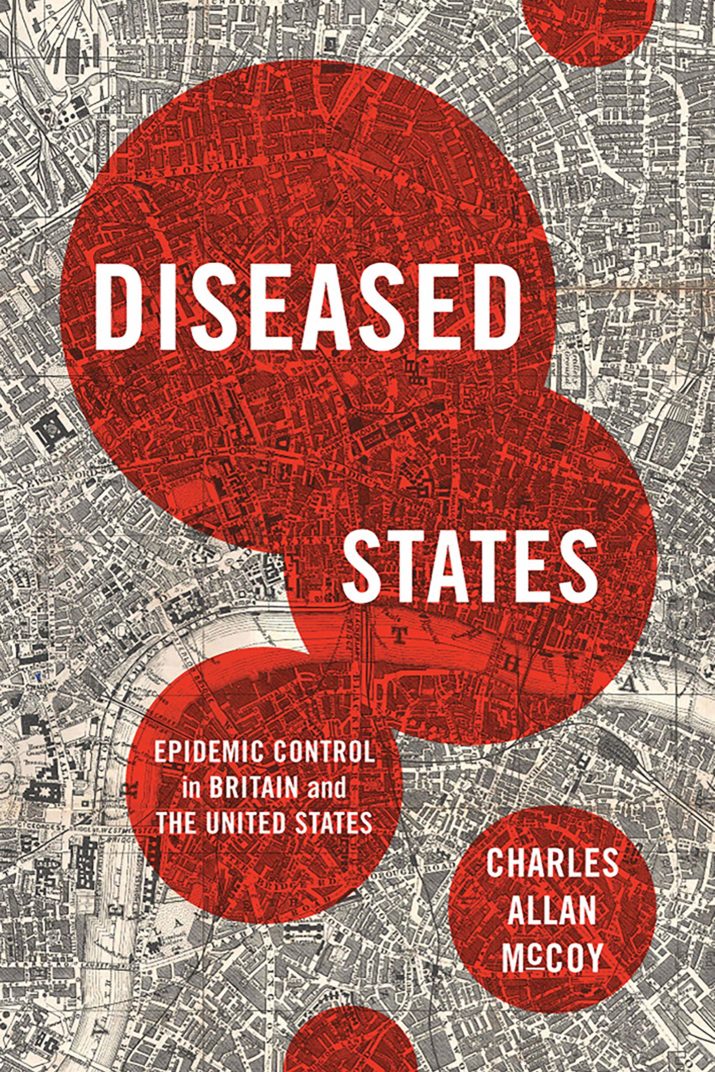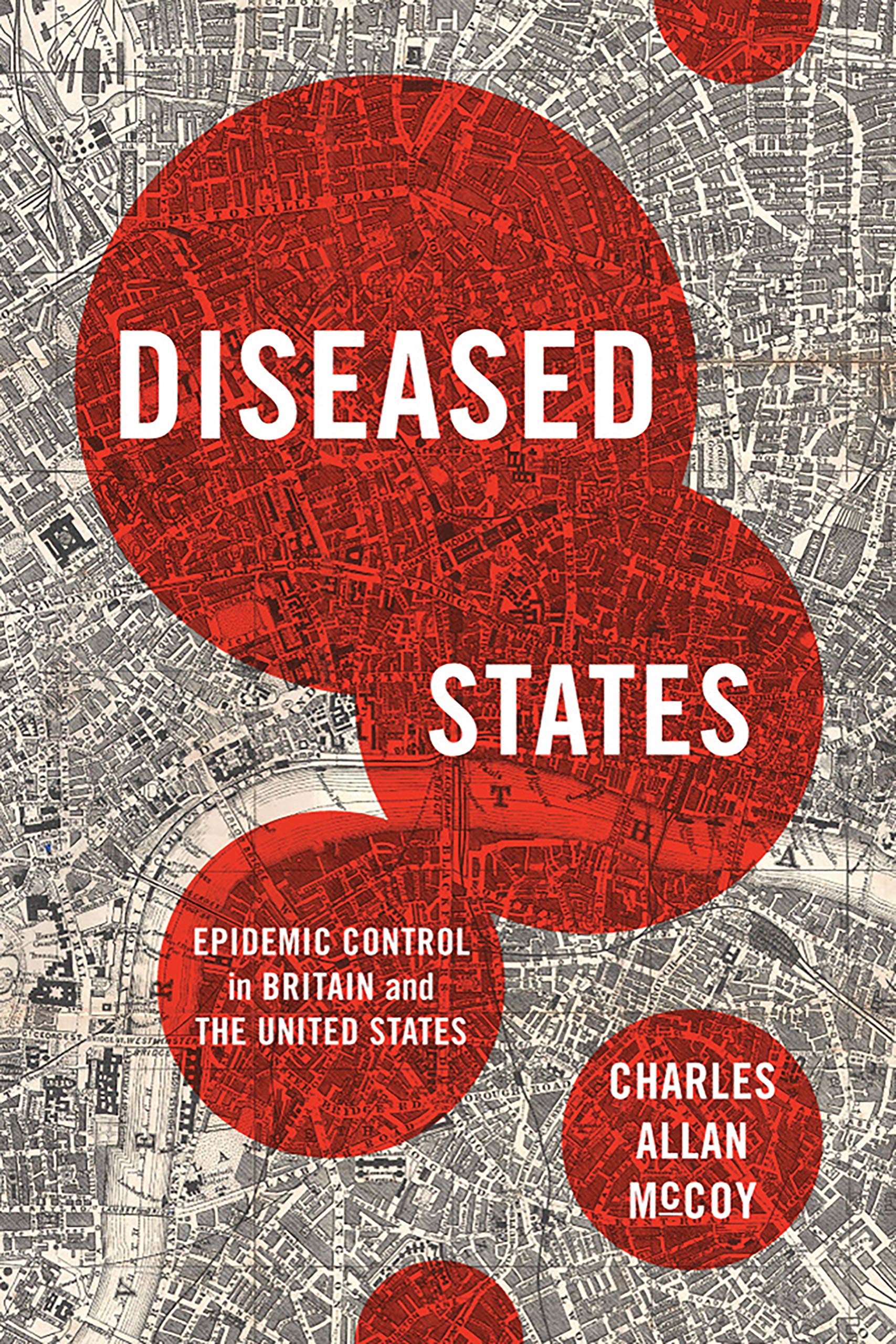

We are all epidemiologists now. Or, if that’s going too far, many of us, living in fear of a novel virus and forced to make difficult, possibly dangerous compromises in our day-to-day lives, have been made to feel the presence—and absence—of government public health policy more acutely than ever before. Or, as Charles Allan McCoy, author of Diseased States: Epidemic Control in Britain and the United States, might put it, the COVID-19 pandemic has changed the relationship between citizens and their governments, perhaps forever.
McCoy’s book is a comparative study of the disease control policies in Britain and the US from 1793, when the city of Philadelphia experienced an outbreak of yellow fever, to the present day— that is, it brings us right up to a pre-COVID world, covering the recent outbreaks of HIV/AIDS, SARS, MERS, avian flu, swine flu, and ebola. But this book is not a chronicle of disease. McCoy, a sociologist, is interested in what the history of disease can teach us about the processes by which states develop long-term disease control and public health policies. While Britain and the US present similar case studies in terms of their history, politics, religions, and cultural values, they have markedly different approaches to disease control. A comparative study between these two nations, therefore, allows McCoy to demonstrate, with admirable precision, why their disease control policies diverged so drastically, and how that divergence continues to influence their response to outbreaks. While Diseased States is about two nations, its explanatory power reaches far beyond their specific histories: most ambitiously, McCoy suggests that disease control policy is a central component of state formation: it increases the “intensive power of the state,” or its biopolitical ability “to manage and utilize its own citizenry” (6).
One of the most significant differences between Britain and the US is that, while Britain developed a coherent set of disease control policies in the 1840s—in response to outbreaks of cholera, typhus, and smallpox—the US, although it experienced a similar frequency of disease, took until the 1870s to begin to develop a systematic state response. There are, McCoy explains, four factors that contribute to this difference in timing. First, during the first half of the century Britain had a sufficiently centralized government, which enabled it to coordinate a response, whereas the US did not; second, Britain had an available theory of disease (the since discredited miasma theory), and the US did not achieve consensus until later in the century, when germ theory was widely accepted; third, Britain conceived of its citizenry as a “social body” to a much greater extent than the US did; and fourth, the British government was pressured to develop a disease control response from nongovernmental organizations, whereas similar organizations in the US were continually forced to respond to the crises that the government failed to address.
Having met these four criteria—centralization, a theory of disease, a theory of the “social body,” and nongovernmental pressure—earlier than the US, Britain, McCoy explains, was able to begin a “response-formation cycle of disease control,” whereby “tactics”—i.e., “ad hoc measures” to deal with a crisis—become “techniques,” or “long-term disease control policies” (18-19). This, you might say, is the central theme of Diseased States: once a state forms a response-formation cycle, it sets itself along a particular path of disease control whose direction is determined by the historical, ideological, and institutional context of its origin. As McCoy demonstrates, the response-formation cycle works by means of positive reinforcement: the state takes certain actions in response to disease and is therefore incentivized to take those same actions the next time an outbreak occurs. At a certain point, that feedback loop achieves a sufficient degree of articulation—it reaches its “threshold effect” (20)—and becomes actual policy. Once the policy is institutionalized, the state’s disease control measures become path dependent: they “set in motion institutional patterns that have deterministic and long-lasting effects” (16). Thus, the fact that the different positive feedback loops of outbreak response in Britain and the US achieved their respective threshold effects—which initiated path-dependent response-formation cycles—at different historical moments and under very different circumstances—thanks to the four criteria listed above—set them along two divergent paths of disease control and state formation. McCoy pithily argues that “origins become destiny” (33).
Diseased States is a complex, conceptually driven book. But its prose is direct, precise, and iterative. The introduction clearly articulates the relevant arguments and concepts. The chapters are governed by a uniform conceptual architecture; each is organized chronologically and split down the middle, covering the situation in both Britain and the US during a specific period of time in painstaking detail. Reading the whole book through is an occasionally redundant experience, but this repetitiveness is both a drawback and a virtue. On the one hand, the book’s concepts stop moving forward, and are merely exemplified, after the introduction. On the other hand, the concepts are complex, and the exemplifications make their comprehension entirely unproblematic. Indeed, after reading each of the chapters, it is difficult not to be convinced by the argument. It is very neatly made.
While Diseased States is commendably coherent when read in full, it will also serve as a useful reference book for an impressive range of scholars. Since it covers more than two hundred years and is methodically organized, it will prove relevant for someone working on, say, Edwin Chadwick’s 1842 Report on the Sanitary Condition of the Labouring Population of Great Britain, or on the 1853 outbreak of yellow fever in New Orleans, or on the origins of the National Health Service in Britain and the Centers for Disease Control in the US, or on the ongoing HIV/AIDS pandemic. The book is full of local insights, many of which complicate any positivistic sense of public health as a progressively better, because more scientific, discipline. For example, I was fascinated to learn that Britain’s theory of disease during the first half of the nineteenth century—miasma theory—enabled the state to develop a coherent and effective response to disease even though it failed to accurately describe the world. Because disease was understood to be a result of filth, the British state focused its disease control efforts on sanitation, particularly on cleaning up the environments of the poor and working class. Although miasma theory has been discredited, it provided the government with a theory of public health that effectively mitigated epidemics.
Miasma theory continued to shape the British state’s approach to public health even after germ theory was scientifically accepted. This is because of path-dependency: the British government invested in a particular set of disease control “techniques,” institutions, and laws that set them along a path from which it became difficult to deviate. For example, because the goal was to sanitize the living conditions of poor and working-class people, British disease control measures were routed through “the welfare sector of the state” (27). By contrast, in the US, where a response-formation cycle was not formed until after the broad acceptance of germ theory, the governing strategy was not sanitation but quarantine—to isolate contagious individuals. And because a positive feedback loop began to form during the Civil War of the 1860s, American disease control was institutionalized in the military.
These differences in historical and institutional origin meant disease control in the US and Britain had very different political orientations, and led them along different tracks of state formation. In general, the US took a more biological, technical approach to controlling disease, whereas Britain took a more holistic view that “requires the coordination of different elements of society” (33). In the US, which sought to control infectious bodies, the state took extraordinarily coercive measures against its citizens. The British state formed a “more subtle, yet paternalistic form of biopower” over its citizens (113): one grounded in persuasion rather than force, education and propaganda rather than coercion and military intervention. In a discussion of the 1918 influenza pandemic, McCoy demonstrates how these differently institutionalized approaches to epidemic led the US and Britain to opposite conclusions about how to control spread: in the US, it was thought to be impossible “to improve the general conditions of society” and the state instituted a “nationwide quarantine”; in Britain, by contrast, “health officials believed that a policy of quarantine was unfeasible but that a general improvement of the physical and social conditions of the country could be instituted” (136). This difference elucidates as clearly as anything how the institutionalization of certain disease control measures means that “for each country only certain courses of action were, in fact, feasible” (136).
The varieties of biopower developed in Britain and the US, with their different theories of disease and institutional homes, reflected and exacerbated their distinct ideological approaches to the question of the “social body.” In short, “while in Britain the idea of a social body was based on the preexisting ideas of class, in America it was formed more out of preexisting ethnic/racial concepts” (24). The British system of disease control, routed through welfare, focused on the health of the working class because, McCoy explains, they were viewed as a vital resource for the economic “health” of the nation: “Just as disease was harmful to a physical body, epidemics were damaging to the health of the social body” (45). It was in everyone’s economic interest to improve the living conditions of the country’s work force. There was no such sense of cohesion in the US. Instead, American health officials viewed hygiene and cleanliness as a personal, rather than a social, concern. Infectious bodies were viewed as threats—typically understood in the register of foreign invasions–that justified military action. This system of disease control was grafted onto the white supremacy and racism that structured American politics and culture: the state’s actions were especially coercive against immigrant communities and ethnic minorities. McCoy recounts the xenophobia and antisemitism directed at Jewish immigrants from eastern Europe in New York City during a typhus outbreak in 1892, the unforgivably harsh measures adopted against Chinese immigrants during an outbreak of bubonic plague in Hawaii and San Francisco at the turn of the twentieth century, and the forced vaccinations (at gunpoint) in the Philippines after US colonization. As McCoy writes, “it was easier to use coercive measures on ethnic minorities…when racist beliefs that identified these groups as ‘disease ridden’ merged with the germ theory of disease that called for the control of potentially infected bodies” (131). Finally, Britain and the US took very different approaches to the always fraught balance between “public safety and personal liberty” (30). British health officials, once again, viewed “liberty” more holistically than their American counterparts, insisting that an individual’s liberty included a freedom from filth and disease. Invasive public health measures were not imagined to contradict, but instead to enable, personal freedoms. In America, predictably, liberty and safety were viewed as opposite interests in a zero-sum balancing act: “a certain amount of liberty must be given up to secure an appropriate degree of safety” (31).
In my experience, it is difficult to read through McCoy’s detailed account of the ideological and institutional differences between the systems of disease control in the US and Britain and fail to conclude that Britain’s sounds better, or at least less harmful. It seems to me that that judgment is implicit throughout Diseased States, and that McCoy is only minimally committed to keeping it implicit. For example, he writes, at the end of a chapter that has focused, in part, on the racism central to American disease control, “although America’s more directly compulsory style may seem more coercive, it is important not to ignore the potency of Britain’s form of biopower” (146). True enough, but the distinction is worth insisting upon: a less coercive, less militaristic, less racist form of biopower is preferable. Additionally, aside from the question of biopower, McCoy concludes, based on the evidence of more recent outbreaks, that the British system has worked more effectively, epidemiologically.
Such differences make a global system of disease control much more difficult. As we are all viscerally aware, now if not before, diseases can quickly become global problems. A piecemeal, inconsistent, nationalized response to global pandemic would appear to be woefully inadequate. McCoy is writing, in part, to health officials and policy experts. He insists that, if we are to develop a global approach to public health, “the distinctive styles of disease control practiced by different nations will have to be contended with” (179). Although it might feel like national approaches to pandemic are ad hoc and willy-nilly, McCoy successfully demonstrates that they are shaped by long histories, rutted in particular institutions. Understanding those histories—informed by the concepts of response-formation cycles and path dependency—is a necessary step to overcoming nationally siloed approaches to the control of global disease.
Diseased States is at its best when it conceptualizes the ways that disease control and public health articulate—or “tighten” (2)—the relationship between state and citizen. It has the virtue of evidencing that thesis in great detail, rather than assuming it. It makes, in certain ways, an unsettling argument, especially in the pall of the ongoing pandemic. “Outbreaks of new diseases tend to be particularly disruptive” (161), McCoy writes in what might be the understatement of the year 2020. The outbreak of covid-19 has been entirely disruptive, and it has surely altered the relationships we have with our various governments. The book’s conclusion gave me a chill:
This book has shown that once a government establishes a certain policy that controls the biological and social lives of its citizens, it rarely if ever gives up this form of control. As the historical development of disease control in the United States and Britain illustrates, once installed these techniques may exercise even greater power in the future than the people who enact them today could ever realize (189).
Pandemics put us in a double bind. This seems especially true of an airborne disease, like COVID-19, that spreads so rapidly. If I’ve learned anything over the past year (as an American citizen), it’s that a government response that pits public health against individual liberty and construes disease as a personal failing can have profoundly tragic consequences. One of the lessons I’m taking away from McCoy’s book is that a system of disease control that encourages social cohesion, that conceives of freedom from disease as an important part of personal liberty, that operates through education and persuasion, rather than coercion, and that has nothing whatsoever to do with the military would be welcome (whether or not Britain has continued to behave this way under COVID-19, I’m unqualified to say, but that’s beside the point). I’m unsure whether McCoy would be happy with my drawing this conclusion. It is a much more descriptive than normative project. Yet, as he acknowledges, new diseases wreak havoc, and perhaps this is not a bad place to start preparing for the next pandemic.
Max Sater recently received his PhD in English literature from Rutgers University. Among other things, he writes about the nineteenth-century novel and the history of science.
Diseased States: Epidemic Control in Britain and the United States
By Charles Allan McCoy
Publisher: University of Massachusetts Press
Hardcover / 224 pages / 2020
IBSN 978-1625345066
Published on February 9, 2021.




